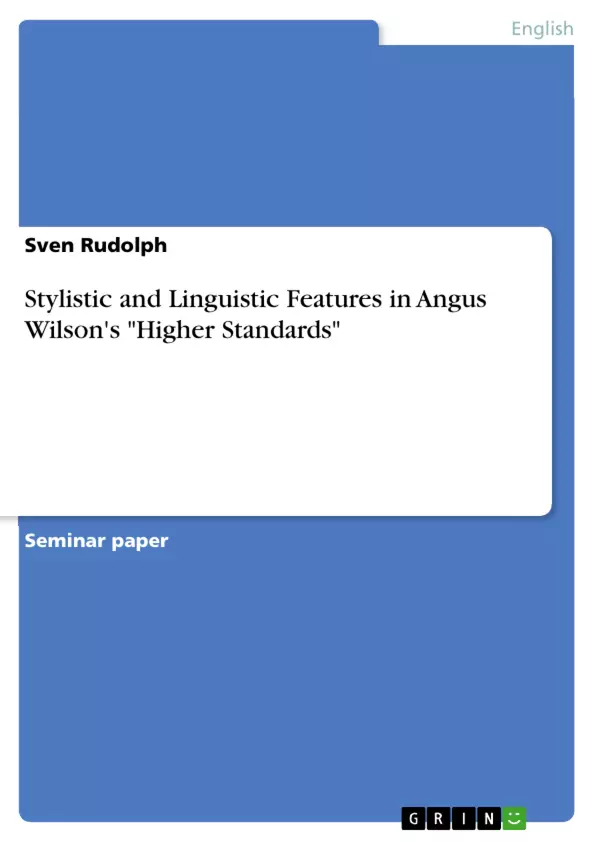In the following text the stylistic and linguistic features of Angus Wilson’s short story Higher Standards will be pointed out and discussed. To complete, a short interpretation based on the results of the linguistic analysis will be provided as a conclusion.
Inhaltsverzeichnis (Table of Contents)
- 1. Introduction
- 2. Analysis
- 2.1 Content
- 2.2 Phonology
- 2.3 Orthography
- 2.4 Lexis/Semantic Fields
- 2.5 Symbolism
- 2.6 Intertextual and Cultural References
- 3. Conclusion
Zielsetzung und Themenschwerpunkte (Objectives and Key Themes)
This analysis aims to examine the stylistic and linguistic features of Angus Wilson's short story "Higher Standards," providing a brief interpretation based on the linguistic analysis. The study explores how language contributes to the story's meaning and character development.
- Character portrayal and relationships within a lower-middle-class British family post-World War II.
- The role of language in revealing social class and generational conflict.
- The significance of repeated words and phrases, particularly "standard," in shaping the narrative.
- Exploration of social and educational standards in post-war Britain.
- Analysis of linguistic devices used to create character and atmosphere.
Zusammenfassung der Kapitel (Chapter Summaries)
1. Introduction: This introductory chapter sets the stage for the analysis of Angus Wilson's "Higher Standards." It briefly outlines the author's biography, highlighting key life events that may inform his writing, and introduces the methodology of the analysis, which will focus on content, phonology, orthography, lexis/semantic fields, symbolism, and intertextual and cultural references. The chapter promises a conclusion that offers an interpretation of the story based on the linguistic analysis conducted.
2. Analysis: This chapter forms the core of the analysis, breaking down the linguistic and stylistic elements of "Higher Standards." It begins by establishing the framework for the analysis, citing the work of Toolan, Verdonk and Stubbs to justify its approach. The subsequent sections delve into a detailed examination of specific aspects of the story's language, preparing the groundwork for interpretation in the conclusion.
2.1 Content: This section focuses on the characters and plot of "Higher Standards." It introduces the Corfe family—Mrs. Corfe, Elsie, and Mr. Corfe—providing a detailed account of their behaviors and interactions during a typical evening. The chapter highlights the descriptions (or lack thereof) of their physical appearances, focusing instead on their personalities, relationships, and the social context of their lives in post-war Britain. The analysis draws connections between their behaviors and the social realities of the time, positioning them as representative of a broader societal group.
2.2 Phonology: This section analyzes the phonological aspects of the story, centering on the repeated use of the word "standard." The analysis examines the multiple meanings and connotations of "standard" in relation to Elsie's profession as a schoolteacher ("standard four"), the group of young adults ("Standard Four"), and the contrasting social and educational standards present in the narrative. The repeated use of this word is further explored in relation to post-war Britain and the "scholarship boys" of the 1950s, linking the word to broader socio-historical contexts.
Schlüsselwörter (Keywords)
Angus Wilson, Higher Standards, short story, linguistic analysis, stylistic features, post-war Britain, lower-middle class, family dynamics, social class, generational conflict, education, "standard," symbolism, character portrayal, cultural references.
FAQ: Angus Wilson's "Higher Standards" - A Linguistic Analysis
What is the purpose of this analysis?
This analysis aims to examine the stylistic and linguistic features of Angus Wilson's short story "Higher Standards," providing a brief interpretation based on the linguistic analysis. The study explores how language contributes to the story's meaning and character development.
What are the key themes explored in the analysis?
Key themes include character portrayal and relationships within a lower-middle-class British family post-World War II; the role of language in revealing social class and generational conflict; the significance of repeated words and phrases (especially "standard"); exploration of social and educational standards in post-war Britain; and the analysis of linguistic devices used to create character and atmosphere.
What aspects of the language are analyzed?
The analysis covers content (characters and plot), phonology (sound patterns, particularly the repetition of "standard"), orthography (spelling and writing system), lexis/semantic fields (vocabulary and meaning), symbolism, and intertextual and cultural references.
How is the analysis structured?
The analysis is structured into three main chapters: an introduction, a detailed analysis broken down into subsections (Content, Phonology, Orthography, Lexis/Semantic Fields, Symbolism, and Intertextual and Cultural References), and a conclusion. The analysis utilizes the work of Toolan, Verdonk and Stubbs to justify its approach.
What is the focus of the "Content" section of the analysis?
The "Content" section focuses on the characters (Mrs. Corfe, Elsie, and Mr. Corfe) and plot of "Higher Standards," detailing their behaviors, interactions, and the social context of their lives in post-war Britain. It connects their behaviors to the social realities of the time.
What is the significance of the word "standard" in the analysis?
The "Phonology" section analyzes the repeated use of the word "standard," exploring its multiple meanings and connotations in relation to Elsie's profession, a group of young adults, and contrasting social and educational standards. Its connection to post-war Britain and "scholarship boys" of the 1950s is also examined.
What kind of conclusion does the analysis offer?
The conclusion offers an interpretation of the story based on the linguistic analysis conducted throughout the document.
What are the key words associated with this analysis?
Key words include Angus Wilson, Higher Standards, short story, linguistic analysis, stylistic features, post-war Britain, lower-middle class, family dynamics, social class, generational conflict, education, "standard," symbolism, character portrayal, and cultural references.
What is included in the provided preview?
This preview includes the title, table of contents, objectives and key themes, chapter summaries, and key words of the full linguistic analysis.
For whom is this analysis intended?
This analysis is intended for academic use, supporting the structured and professional analysis of themes within the text.
- Quote paper
- Sven Rudolph (Author), 2010, Stylistic and Linguistic Features in Angus Wilson's "Higher Standards", Munich, GRIN Verlag, https://www.grin.com/document/155651



